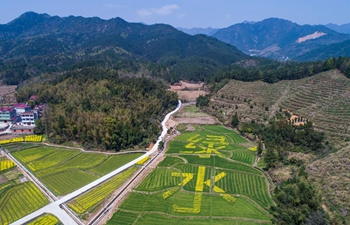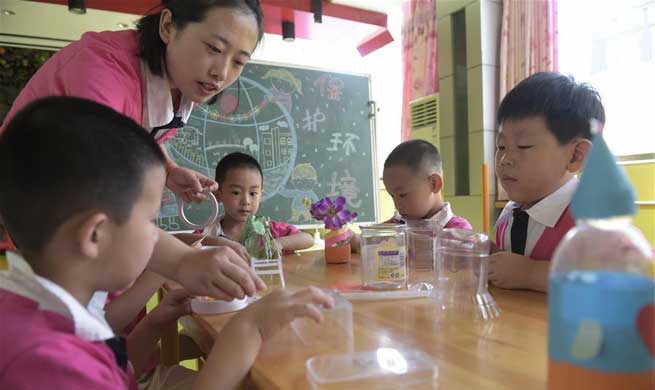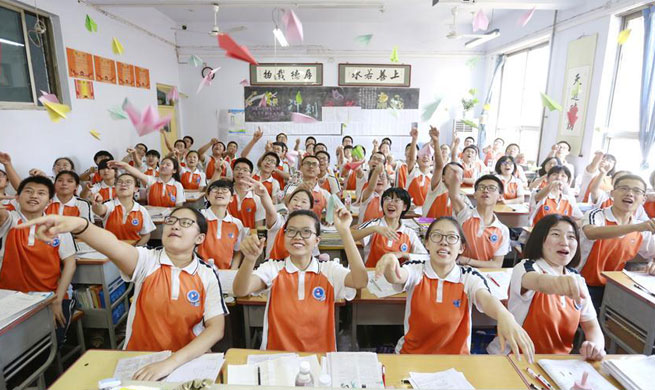URUMQI, June 6 (Xinhua) -- The Tuman River winds under the 40-meter high loess mound in the old town of Kashgar. Legend has it that a flood about 800 years ago carried massive amounts of ochre mud along the riverbank. Local Uygurs call it "seghiz."
A craftsman found it perfect to make pottery, so he set up the town's first pottery workshop on the mound. Soon more people were drawn here to craft various artistic wares using mud, water, and fire. They were called "kozichi yar beshi," or "the potter families on the mound" in Uygur.
As a sixth generation kozichi yar beshi, Tursun Zunun has taken up the family business. For centuries his family has witnessed the place boom as ceramic wares were used by every local household.
According to archaeologists, the history of using pottery in Kashgar, northwest China's Xinjiang Uygur Autonomous Region, dates back thousands of years -- a large number of pottery vessels including jars, bowls, basins, plates, and cups have been unearthed from a Neolithic ruin about 50 kilometers from the city.
However, life is now quite different. While Zunun still rotates a wooden wheel in his home in the old town, from his balcony he can see a giant Ferris wheel standing among modern buildings in the new town. As the city developed, products made of metal, plastic, and other modern materials have replaced ceramics.
The 60-year-old man, one of the few potters who remain on the mound, sometimes worries that his craft is in danger.
To save this family legacy, Zunun has been forcing himself to break the rules which have been strictly obeyed by kozichi yar beshi for centuries.
No teaching people outside your family. That was the first rule he broke.
"All my three daughters are married. My only son went to the police academy. No one in my family wanted to learn. So I advertised for apprentices, but for a while no one responded," Zunun said.
To his surprise, two students from the Republic of Korea (ROK) came to his door.
"I don't mind breaking this rule, teaching the skills to strangers," said Zunun, "I gave them Uygur names, Yishajan and Yumitijan, and they are my apprentices."
RETURN HOME
The workshop has two stories. The first step in making fine pottery is preparing the clay on the first floor. It's also where the then six-year-old Zunun touched clay for the first time.
"I helped my grandfather collect mud from the Tuman River. Then I stomped on the clay to help with the kneading," Zunun recalled, "My grandfather said only with good clay can we make good pottery, so we must select the mud and carefully remove impurities like bits of wood, rocks or sand."
But his grandfather's teaching was beaten by modern attractions when pottery sales plummeted in the 1980s as a result of influx of industrial products into the local market. Many young potters, including Zunun, left their wheels. "Pottery making is all manual labor. It was so hard that I gave it up," he said.
The young apprentice left the mound in 1983 when his grandfather passed away. He took temporary jobs outside Kashgar. His father was the only working potter in the family.
Zunun didn't return until a decade later when his father was too old to carry on. He completed his studies with his father and took over the workshop.
But he felt he couldn't stop the industry dying. The once more than 100 pottery workshops on the mound had been reduced to just five.
Zunun felt lost. He didn't know whether he should stay in the dying industry. He and his wife had a dispute over it.
"My wife said I could make more money if I took a different job. But I just couldn't let the craft go," Zunun said, "And now my perseverance has turned out to be the correct choice."
The reputation of the few remaining kozichi yar beshi began to spread in 2006 when Kashgar pottery was included in China's first list of intangible cultural heritage.
As an inheritor of this intangible cultural heritage, Zunun receives an annual subsidy of 4,800 yuan (764 U.S. dollars) from the government.
To save the craft, the local government also worked with tourism companies to help turn a part of Zunun's workshop into an exhibition room open to tourists. More tourists have started to visit Kashgar as a renovation project was launched in 2009 to protect the old town. Xinjiang saw a record high of 107 million tourists in 2017.
Zunun's pottery has proven popular with tourists, especially those from Japan and the ROK. That's how his two apprentices found him.
PRIDE AND COMPROMISE
As the only person in the family who has inherited the craft, Zunun is proud of his rustic style.
"I make pottery the same way my father, my grandfather, and my grandfather's grandfather did," said Zunun, his timid face glowing when he steps into his dim workshop.
On the second floor of his workshop Zunun shapes the pieces when the clay is ready, the key step of the creation. He sits in front of the wheel in the middle of the room, the only place illuminated by the sunlight that comes through the skylight on the roof.
Various finished products sit on shelves around the room, glazed and reflecting the light, like stars studding the night sky. Most of them are already reserved for customers across the world.
The turntable of Zunun's wheel is made of desert poplar wood. Instead of an electric motor, he uses a foot power to rotate the wheel, and pulls the clay gently upwards and outwards into a hollow shape. In the process a vessel gradually takes shape.
After painting and glazing, Zunun places the clay into the straw-fired kiln. Baked at 900 degrees Celsius for seven hours, the piece of mud is finally transformed into a delicate artwork with simple dark brown patterns and khaki glaze.
Kashgar potters do not use set designs or molds but use their feelings to guide the design. As a result, no two pieces of Kashgar pottery are the same, and it's difficult to achieve large-scale production. Therefore, the time-honored art was overtaken in the tide of industrialization.
"Many ceramics sold on the market today are not made in the old way. People began to use electric wheels and molds. In that way, everyone can produce pottery," said Zunun.
He insists that pottery made with modern techniques will "lose its appeal," but he had to compromise on the second rule, stick to old methods, after his third apprentice arrived.
Young Zulipkar Ababakri is full of bold, innovative ideas. He suggested using an electric kiln, which is more efficient and more environmentally friendly.
This "crazy" idea was initially rebuffed by the old potter, who said no to changing the process that had been preserved for generations.
But Ababakri was persistent and patient enough to persuade Zunun. In 2015, the first electric kiln was set up in Ababakri's workshop. It raised the production yield at just one-fifth of the original cost and emits less smoke.
"Now I'm breaking another rule. I will teach whoever wants to learn, even if they use modern tools," said Zunun.
The third rule -- teach only men -- was recently defied.
Zunun's youngest daughter Iminhan has recently returned home to study the family tradition.
"She is well on her way to being the first female potter in Kashgar. I'm happy that she is going to carry on my legacy," said the proud father.
"In the past pottery making was just a livelihood for my family. But now it is more than that to me. It is a part of our history that we must preserve," he said.

















